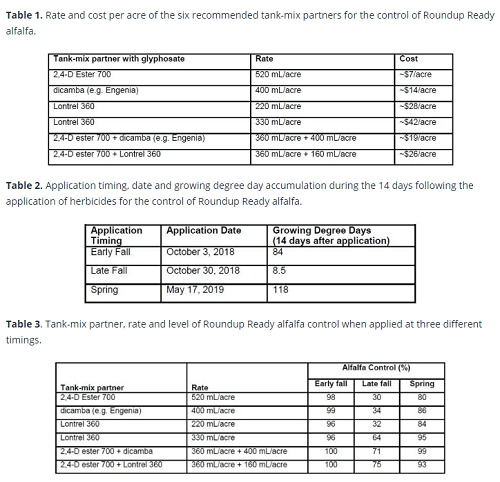Six tank-mix partners are recommended for the removal of Roundup Ready Alfalfa and since they vary significantly in cost (Table 1), their effectiveness was evaluated in a trial conducted at the Elora Research Station in 2018-19. Growing degree day accumulation after herbicide application appeared to have the greatest effect on the control of Roundup Ready alfalfa. Presumably because alfalfa has a base growing temperature of 5°C and when air temperatures following herbicide application rarely exceeded 5°C, alfalfa growth was stagnant (Table 2), and control was unacceptable. Conversely, when air temperatures following herbicide applications were often above 5°C, all tank-mix partners provided similar control of Roundup Ready alfalfa (Table 3).

Crop plant back considerations: The application of Lontrel 360 (clopyralid) increases the risk of unacceptable stand establishment of soybean or dry edible bean. If wanting to use Lontrel 360 for the control of Roundup Ready alfalfa, corn or cereals would be the safest options to plant back after application. The application of dicamba in the spring would also increase the risk of unacceptable stand establishment in dry edible beans or soybean, unless planting a dicamba tolerant (Xtend) soybean cultivar.
Application Tips for removal of Roundup Ready alfalfa according to the Roundup Transorb and Weathermax labels:
– Tank-mix partners should be applied in the fall when Roundup Ready Alfalfa is between the pre-bud to start of flowering stage, but ideally at the bud stage of growth.
– Tillage at 2-3 weeks following application can improve control and consistency under stressed conditions (drought, frost, cold temperatures etc).
– Mix with water to achieve a total applied volume of 100 L/ha (10 U.S. gal/acre).